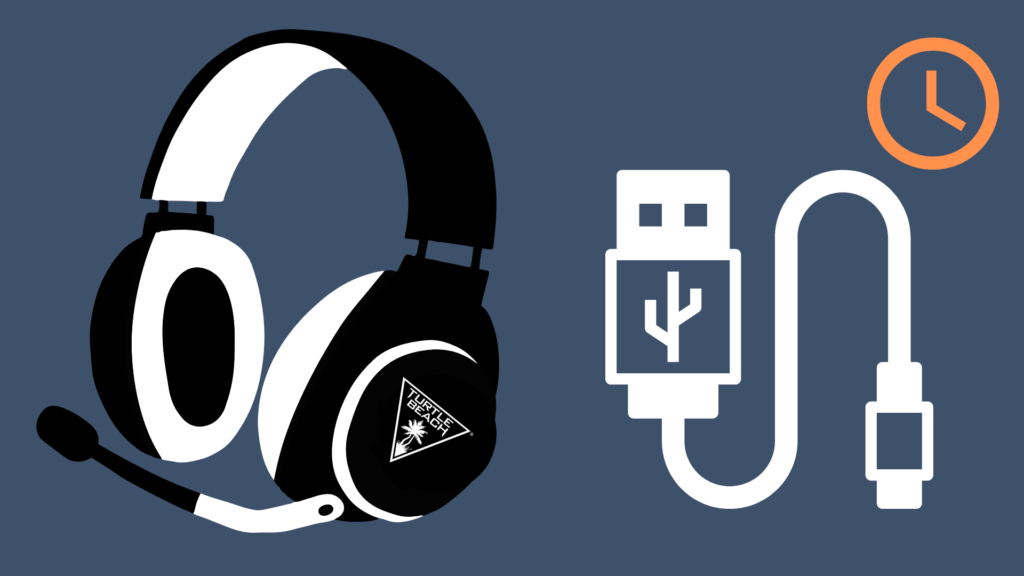How Long Does Turtle Beach Stealth 600 Take to Charge?

The Turtle Beach Stealth 600 is a set of wireless headphones that doesn’t need a direct connection to your console or PC to function. Of course, this means that it needs a rechargeable battery as a power source. The headphones come with a USB charging cable that works with any standard wall outlet.
The Gen 1 Turtle Beach Stealth 600 wireless gaming headset takes three to four hours to completely recharge. It charges with a micro-USB cable that plugs into the headphones themselves, and a USB type-A connection that plugs into the USB port on your console. Battery life differs between models, but the standard Stealth 600 has 15 hours of battery life on a full charge.
When charging the headset while it’s turned on, an LED light will change from red to green after it’s fully charged, and if you charge the device while turned off, the LED will turn on after the device is charged. If you find yourself storing the Stealth 600 for a long time without using it, don’t let the battery die first—charge it for some length of time before a long-term storage period of greater than three months to protect the battery.
How Long Does the Turtle Beach Stealth 600 Take to Charge?
The Gen 1 version of this device needs somewhere between 3-4 hours to charge from a low battery. It will work with a 12-volt adapter plugged into a standard wall plug, and you can use any USB type-A to Micro-USB charging cable to plug it in. However, it’s recommended that you charge the device by plugging it into the USB type-a port on your console.
When the device is turned on and at a low battery charge, it will indicate this with a slowly pulsing or “breathing” red light. Once plugged in, it will show a solid red light.
Be sure not to store the device at temperatures higher than 113 degrees Fahrenheit (45 degrees Celsius). High temperatures damage the battery and can cause it to lose capacity, leak, or even rupture violently.
The Stealth 600 uses a firmware program to control its wireless connection and regulate other processes, including charging. The firmware is responsible for allocating battery power as efficiently as possible, and more up-to-date versions attempt to improve this feature. Be sure to update the device’s firmware whenever a new version is available to ensure healthy battery life and capacity. Read on for instructions on how to update the headphones’ firmware.
How do I Recharge Turtle Beach Stealth 600 Headphones?
The Micro-USB recharging port for these headphones is located on the bottom of the left-side ear cup next to the microphone.
It’s time to recharge your Stealth 600 headphones when you notice a pulsing red LED on the device. To recharge the headphones, simply plug the charging cable into the miro-USB port and the USB type-A port on your wall adapter. If you’ve plugged the device in while it’s turned off, an external LED will light up when it’s fully charged. Otherwise, a red LED will light up once the battery is plugged in and change to green when it’s fully charged.
Check out Turtle Beach’s support article about charging LED behavior here.
Can I Use My Stealth 600 Headset While it’s Charging?
Yes, you won’t damage the battery by doing this, and the device will simply charge at a lower rate when in use. Your console’s USB type-A port is the perfect place to charge the device while it’s running, provided you have a long enough USB type-A to micro USB cable.
How Do I Install a Firmware Update on My Stealth 600 Headphones?
The Stealth 600’s firmware determines which processes are activated in the headphones at what time. Sometimes a firmware update will choose to allocate power in a way that improves battery life by deactivating a non-essential process at a certain time. Firmware updates may have no effect on battery life or even have a negative effect when they program the device to use more power at certain times. However, firmware changes are always made with a view to making the device function better overall, so they’re worth any slight decrease in battery life they may cause.
To update your Stealth 600 headphones’ firmware, head to the Turtle Beach Audio Hub website on your computer and download the latest version of the Hub software. After it’s installed, launch the software and plug your headphones into your computer’s USB port. The program will automatically detect the device and install any necessary updates.
Will I Overcharge My Stealth 600 Headphones’ Battery if I Leave it Plugged in for Over 4 Hours?
The short answer here is no. Like all modern rechargeable devices, the Stealth 600 headphones have a built-in battery circuit that times how long the battery has been charging for and cuts off incoming current when the battery reaches its full charge.
The only circumstance where it’s remotely possible to overcharge the battery is if you unplug the device when it’s fully charged and then immediately plug the device back into your console or 12-volt charger. This could confuse the battery’s charge flow circuit by resetting the timer which tells it when to cut off current to the battery, causing the battery to overcharge.
How Long Do the Gen 2 Turtle Beach Stealth 600 and Stealth 700 Headphones Take to Charge?
The Gen 2 Stealth 600 wireless headset does not have an improved battery life over the Gen 1 headset. It does include the power-saving feature of turning off by itself when not in use for 10 minutes.
However, the Gen 2 MAX headphones from Turtle Beach, a variant of the Gen 2, have a vastly improved battery life over both the basic Gen 2 and the Gen 1. Turtle Beach claims that its battery life is twice that of the original, although real-world tests saw an even bigger battery life increase from 15 hours to 78 hours and 32 minutes.
Both versions of the Gen 2 Stealth 600 use a USB-C to USB Type-A charging cable rather than a micro-USB cable.





